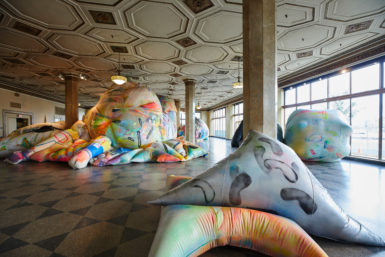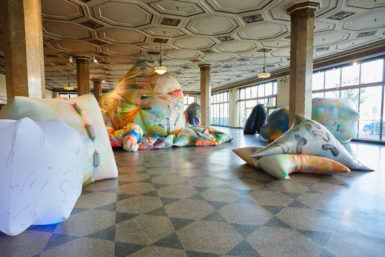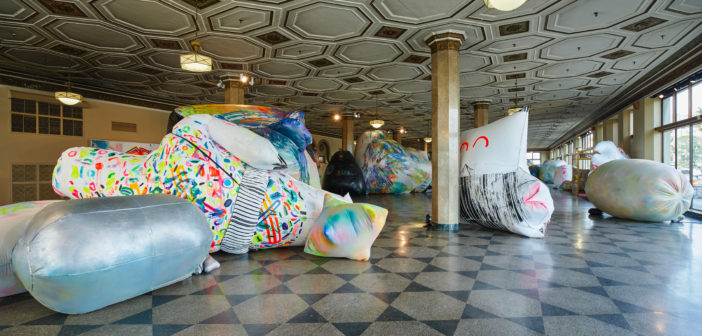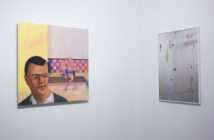Those crazy female foreigners are alive and kicking. So claims—in texting-slang—the title of Scottish artist Claire Ashley’s current solo exhibition at Boston University’s 808 Gallery, (((CRZ.F.4NRS.AAK))). It’s an attention-grabbing statement, and much the same can be said for the art itself. Giant, neon-bright inflatable sculptures are visible to passers-by on Commonwealth Avenue through the gallery’s floor-to-ceiling, street-facing windows. Those who enter the gallery to get a closer look will not be disappointed, yet they should not expect a straightforward explanation. Like the exhibition’s title, the artwork exists in Ashley’s playfully coded world.

Claire Ashley, Installation of (((CRZ.F.4NRS.AAK))) at 808 Gallery. Courtesy of BU Art Galleries.
(((CRZ.F.4NRS.AAK))) delivers that Instagram-friendly “wow factor” for which many current-day installations are striving. In addition to several paintings, there are approximately 30 inflatable sculptures. The larger-than-human-scale sculptures are the stars of the show, wacky and easy to love for their nostalgic use of colors inspired by ‘80s fashion and street art. However, they are nonetheless difficult objects to identify, even with the pop-culture references in their names. With the air of a hapless Trojan Horse, mylittlepony stands squashed between the floor and ceiling. Bugs Bunny—more than 22 feet long—lies across on the floor, perhaps bowled over by his own eye-popping color and size. Many are covered in shapes and symbols, like hashtags or triangles, whose meanings are not clear.
However, during a conversation with Ashley over email, she said, “The symbols I often use are deliberate and relate to language in that I use them as markers on a map of sorts. X marks the spot, whether that is a treasure or erogenous zone, or + for an eye, nipple, belly button, etc.”
Marking the erogenous zones on a neon-colored blob is humorous, but it also fits with Ashley’s insistence on (((CRZ.F.4NRS.AAK))) as a feminist critique of the art world. Even since the Guerilla Girls began their famous campaign for equality in museums and galleries, the question of whose work is shown (and whose bodies are put on display and in what context) has been the core of much soul-searching among curators, dealers, and others who think critically about the art world. Speaking about how her largest works reach the ceiling, Ashley said, “It embeds the idea of each form/body operating as a growing, living being, and the idea of my largess taking up as much space as possible in the work I make—the brash, loud body in space rather than the subtle, delicate, beautiful body.”

Claire Ashley, Installation of (((CRZ.F.4NRS.AAK))) at 808 Gallery. Courtesy of BU Art Galleries.
While the surfaces of Ashley’s “bodies” display maps of erogenous zones and attract gallery-goers with bright colors as if demanding to be seen and desired, their forms activate the space with surprisingly passive gestures. (One work is even called Lazy Goth.) These inflatables sag, bulge, and lean against one another for support, refusing to perform the high-energy roles one would expect from their appearance.
Yet this inaction is still a subversive act. Most exhibitions—even immersive installations—are designed to create a specific path for the viewer. In (((CRZ.F.4NRS.AAK))), there is no obvious point of entry. The inflatables sprawl in loose knots like inner tubes gyrating along a lazy river, and viewers simply plunge in, accommodating their paths to whatever irregular negative spaces they find. According to Ashley, she loves “what happens visually when they all collide or exist within the ecosystem or environment of the installation” and uses “both singular and familial thinking in the work.”

Claire Ashley, Installation of (((CRZ.F.4NRS.AAK))) at 808 Gallery. Courtesy of BU Art Galleries.
Familial thinking is an intriguing concept when applied to (((CRZ.F.4NRS.AAK))). Some of the inflatables are small as bean bags. These small-scale pieces exist in the shadow of the larger ones in a way that suggests a parent-child relationship. Ashley began working in inflatables at a time when she was also raising three children and influenced by the energy and humor of cartoons, balloons and plush toys. While to this reviewer, (((CRZ.F.4NRS.AAK))) as a whole embodies potential rather than kinetic energy, childish-ness does animates the smaller pieces. This is literally true of a quartet of mid-sized inflatables that performed at the exhibition’s opening reception (with the help of humans zipped into their inflated bellies). Shaking, singing, swaying, and bouncing into each other (and into delighted reception attendees), they were certainly “alive and kicking” in a way that the larger works are not.
Visiting (((CRZ.F.4NRS.AAK))) is like embarking on psychedelic journey, potentially full of meaning if you don’t get mired in questions first. What does Bugs Bunny have to do with feminism? Why is this particular blob black and blue, and that one all iridescent? Pop-culture idiom becomes cryptic. The simplest symbols are not what they seem. Those crazy female foreigners must be up to something, but it is not Ashley’s priority to spell it all out for us.
Claire Ashley: (((CRZ.F.4NRS.AAK))) is on view in BU's 808 Gallery through December 3.




